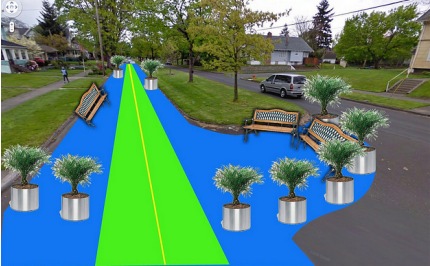
The Ask BikePortland question we shared on Wednesday has sparked exciting ideas and a spirited discussion about NE Ainsworth Street.
“I live directly on Ainsworth and the day I started cycling was the day I started parking my car on a side street… As a resident I would love to have the speed limit on Ainsworth reduced to 20 MPH!”
— Kerry
A wide range of opinions about riding on Ainsworth have been expressed — from people who think it’s crazy to bike there at all, to those who think it’s fine as is, to those who lament the fact that it’s so dangerous. A few of the commenters not only shared their opinions, they’ve also drawn up illustrations showing how to do it.
Steve Bozzone, who volunteers with local livable streets activism group Active Right of Way (AROW) and also maintains the Intersection 911 blog and Twitter feed, wrote in to say that he was intrigued by the “juxtaposition of a great community asset (the park in the center median) surrounded by a horrific street that people don’t want to walk on, let alone bike.”
Bozzone proposed an idea to extend the Ainsworth Linear Arboretum to one side and make the street one-way, while leaving the other side as park space and a multi-use path. (You can see Steve’s illustration of that idea at the top of this post.)
Reader David Brokaw wrote in with a different idea that he feels would make room for a bike lane…
“Instead of ripping out any of the center median, you could install recessed parking bays at varying intervals along the street. There aren’t a huge number of homes that front onto Ainsworth, so you probably would only need 2-3 stalls per block. You would only need to recess the stalls a few feet to have enough room for a bike lane.”
He also shared an illustration of it…
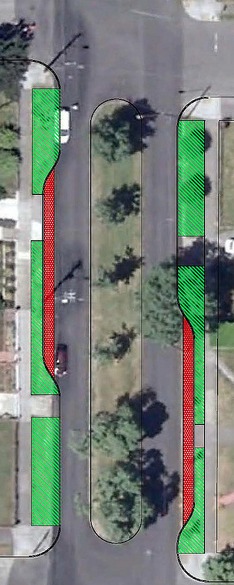
Another thing that came up in many of the comments is a feeling that Ainsworth’s 30 mph speed limit is too high.
The idea that NE Holman (which is just one block North) is a bike boulevard also came up. While Holman is a nice street to bike on (if you don’t mind the bumps), it seems to me that people who choose to ride a bike instead of driving a car shouldn’t have to avoid any local, residential streets.
Read more great insights and ideas about how to make Ainsworth a more livable street in the comments to our post on Wednesday. Who knows, maybe one of them will spark some action.

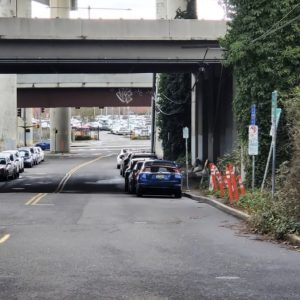
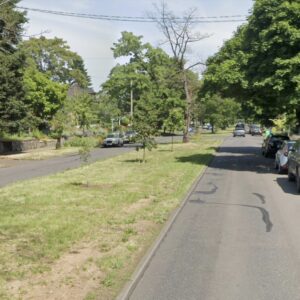
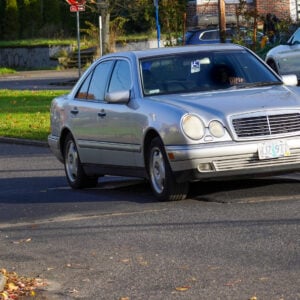
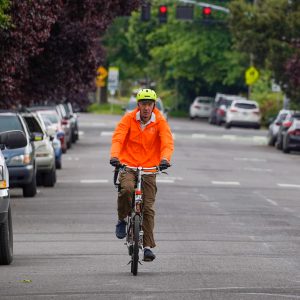
Thanks for reading.
BikePortland has served this community with independent community journalism since 2005. We rely on subscriptions from readers like you to survive. Your financial support is vital in keeping this valuable resource alive and well.
Please subscribe today to strengthen and expand our work.
I love the illustrations. Keep the ideas coming. The best way to show change is by making our own suggestions.
BTW, does anyone have dimensions for the street?
In the first example how exactly do homeowners on the park side of the street get access to their driveways?
Even if they get on street parking this makes it difficult to receive deliveries, or even to move out of the house when sold.
So, is there a number for how many bicycle riders have been injured here, by motorists?
Would people have to drive in the bike lane to get in their driveway?
What about taking one side of the couplet and making it a two-way bikeway. Take the other side of the couplet and make it two-way auto-only lanes. Result: completely separated facilities where bikes can do their speed and cars can do theirs. Parking would have to be removed, but some residents have already said they’d be willing. Cars then would be head on with each other on a relatively narrow street and their own lives are in danger; you bet they’ll slow down naturally then.
Where is the other half of the one-way couplet?
I know the cost for the retractable bollard is high but it would be sweet to allow EMS to retract them in an emergency and use the cycle track as a high speed cut through when needed.
Once the bollards are in they can grind down the speed bumps and the large emergency vehicles could get some real speed so they could respond to emergencies.
Sure, it would mean sharing an otherwise non-vehicular space but:
>it would very infrequent
>you would have lots of visual and auditory indications that something is coming
>generally speaking drivers of large EMS vehicles have MUCH better driver training.
As infrequent as it would occur I’d be more than happy to get out of the way for the small time it takes a ambulance or fire truck to get through; don’t want po-po using it as a cruising strip but emergencies are emergencies and the facilities would have been payed for by everyone including those who don’t use it.
You’re kidding me that “people don’t want to walk on” Ainsworth… 90 percent of people in Portland would love to live on a tree-lined boulevard with detached sidewalks buffered from the street by a 12′ planting strip. There’s a reason those houses cost so much…
Yeah, biking can be uncomfortable because taking the lane is awkward with the light-to-moderate use of on-street parking (too many parked cars to just ride in the parking lane, too few parked cars for the driver behind you to think you’re justified in not pulling right to let him pass). I’m not convinced that the street is “dangerous” by design. Rather, it sounds from most testimony that any danger is created by impatient drivers that make unsafe passing movements, and that can happen on any residential street in the city with on-street parking (all of them).
I agree that the posted speed of 30 seems a bit high, but remember that until PBOT takes speed control back from ODOT, 25 is the lowest speed limit you’ll get for any street in the city without a special exception (like school zones).
The ideas offered are creative, interesting, and great to think on/dream about… but sorry to harsh your mellow, there’s no way Ainsworth is important enough to justify a full-scale remodel. Removing and rebuilding curb and gutter along the two miles between MLK and 37th would probably land in the ballpark of a million bucks – money that could be better spent elsewehere.
Wait a second… people don’t feel safe on Ainsworth? I rode on this street every day for a year as part of my bike commute at an old job and always felt perfectly safe. I always found it much safer than Killingsworth or Dekum. Weird… if anything put a bike lane on both sides, get rid of street parking. I think I remember all those homes having driveways anyway.
I didn’t say couplet people! Why do we need a couplet? This should be a quiet residential street. Want to go West? head on up to Killingsworth.
I understand the concern, traffic would flow onto residential streets to get around this. An alternative, as John pointed out, would be 2-way traffic on the other side, at the cost of parking (perhaps the parking could be saved by notching out the planting strip).
Access to driveways – no problem. Local traffic would still have access to their driveways through the same street, but through-drivers wouldn’t dare try it (you’d have to drive really, really slow to avoid all the planters, street furniture, etc).
There’s certainly challenges, but we’ve got to start somewhere. The calming and greening of Ainsworth should be a community priority, but we’ve got to spark the imaginations of Portlanders, to really rethink what’s possible. Our imaginations are often limited by what we already see, what’s already on the ground.
On Ainsworth, all I can see is a great park that no one uses. We can do better!
It’s been said before, but Sunday Parkways was a real eye-opener to the potential of this street. Until I rode Ainsworth the last two years on SP, I didn’t really give it much thought. Thanks, SP!
Jonathan –
“people who choose to ride a bike instead of driving a car shouldn’t have to avoid any local, residential streets. ”
Amen. I’d only add that in my view this shouldn’t be limited to local, residential streets. What about Foster and SE 39th Ave, for instance?
Have you seen this?
http://jalopnik.com/5533260/why-street-signs-make-traffic-more-dangerous
It discusses Hans Monderman and his efforts to improve safety on streets by increasing drivers’ uncertainty… 🙂
Another visual for reimagining Ainsworth —
http://biketemple.blogspot.com/2010/05/thousands-baptised-at-sunday-parkways.html
Yours in The Faith,
Pasture Ted
For starters, I vote to knock the speed limit down to 20, and re-time the traffic signals to 15 mph. And put up some nice rustic signs every block or two on the median that say “Welcome to the Ainsworth Arboretum — est. 2005.”
Then we’d start to get through traffic diverted over to Killingsworth and have more political support for the full makeover.
We had a great time on that median at Sunday Parkways, it would be a real asset to the city to have at least half of the street car-free.
Pasture Ted
Another idea would be the German ‘Spielstrassen’ model: Knock out the side walk curbs, have parking bays lined out with raised curbs, don’t offer clear lines of sight – confusion about where to drive is a quick method for slowing traffic…
“it seems to me that people who choose to ride a bike instead of driving a car shouldn’t have to avoid any local, residential streets”
And those that choose to drive a car should be forced to avoid local, residential streets by having access restricted?
Why not make surface improvements to Holman and do a similar bike boulevard treatment to the road south of Ainsworth, so there’s a bike boulevard “couplet” on either side. Seems like that’s what they’re doing with Going and Skidmore on either side of Prescott.
http://www.flickr.com/photos/60961560
What ever happens avoid the pinch points in the top photo. I feel and have experience that these do not encourage motorists to drive slower, but in fact make them drive faster to beat cyclists through the narrow passage.
Based on the placement of the planters and benches blocking the cross areas, in the top example, there’s no room for a car to get down the park side.
“…a horrific street that people don’t want to walk on, let alone bike.” Does Steve Bozzone live in the neighborhood? I totally agree that there’s room for improvement on Ainsworth, but it’s not like we have a 6 lane freeway ripping through a residential neighborhood here. I intentionally take it for walks and find it quite pleasant. If there’s a lot of traffic, I ride on Holman or Going. It’s not perfect, but it could be a lot worse.
I didn’t say couplet people! Why do we need a couplet?
Because when you take a street that functions like an arterial and reduce it to one way, traffic engineering requires that you replace that capacity in the other direction nearby. There’s a reason why every one way street in the city that is more than a few blocks long is part of a pair. Why would this be any different?
“On Ainsworth, all I can see is a great park that no one uses. We can do better!”
I go to Alberta Park and Fernhill Park 3-4 times a week and they are always being used by folks. ???
We just dumped a lot of money into making Holman a bikeway; I think it would be wise for us cyclists to take a moment to be grateful for that update.
As a resident of another neighborhood with a park block similar to those on Ainsworth, I’d like to point out that we have many of the same problems and at least as many cyclists on our street. Another City resource quickly falling into decrepitude; NE 72nd “Park Blocks”.
I never minded Ainsworth, I allways fealt more intimidated on Alberta
I live on Holman and walk and bike on both Ainsworth and Holman all the time. I’ve seen a marked increase in pedestrian and bicycle use since the sharrows and speed bumps went in on Holman which is great for me. I do find it odd that more pedestrians don’t use Ainsworth as it’s a much more pleasant route. I always take Ainsworth when I’m walking.
I also use Ainsworth when I drive as it’s a great direct route to parts west. I never drive over 30 mph, usually 25, and thus almost always get a driver on my tail within a few blocks. Most people slow down and then back off but yeah, the speed limit on this street should be lowered. I’ve never experienced the menace other people are talking about though. I’d love to see Ainsworth get a 20 mph speed limit.
Talk about making a mountain out of a mole hill. Leave Ainsworth alone. It’s fine as is.
Confiscate half of this residential street from the homeowners’ use and you’ll create a perfect storm of public opinion against bicycles. There are plenty of other quiet streets parallel to Ainsworth that are just fine for biking as is. Funds would be much better spent on bike safety education and programs to help more people integrate bicycles into their lifestyles.
What would be the process for trying something interesting like this on Ainsworth?
Seems like the obstacles are obvious: how to deal with the need for cars to drive through ainsworth? How do you accommodate resident parking? How do we fund the changes(it would be interesting to know how much the city intends on maintaining half of this road over the next 15 years – there might be savings enough to justify the planter boxes, benches and bike path.) If the world comes to an end because 20 blocks of one traffic lane and 100 parking spots are removed, we can always just undo it.
If the hawthorne bridge can be made a park with volunteer effort and minimal cost, why can’t the arboretum get the same treatment? All in all, seems like a really affordable, efficient way to build a great new park!
And those that choose to drive a car should be forced to avoid local, residential streets by having access restricted?
It is time to tame the bull in the china shop.
I imagine that only those who use side streets as arterials will take issue. People who live on a street with changes such as these would probably be pretty happy. Collect data on streets that have been turned into bicycle boulevards or have had traffic calming added, my guess is that housing values jumped 20% or better.
re comment 9, a great many of these houses in fact do not have driveways.
re comment 14, most of the intersections through here are regulated by stop signs, so timing lights would have no effect.
re comment 16, yes, residential streets should not be used for through traffic.
re comment 22, how much money was “dumped” on the holman bikeway? apart from paint, which was paid for by a federal grant, i see nothing.
ride on holman, duh.
I see two aspects to the question —
1. What can we do now, with existing political and financial support?
2. What do we want Ainsworth to look like when we have 25% of all trips by bike?
Portland has proven that there are lots of ordinary Americans perfectly willing to use a bike as their primary mode of transportation. But only if there’s good routes, and lots of other people doing it.
To get from the current 8% of commuters up to 25% of commuters, we’ll need to make improvements to routes. The more improvements, the sooner the improvements, the sooner we get there.
For the easy, quick fixes, I think reducing the speed limit to 20 mph should be easy, and rename it to “Ainsworth Parkway.” with rustic signs, etc. And maybe a woodchip path through the median and nice labels for the trees and benches to sit on.
Then you’d get more people biking on it. This “fix” would be pretty much instantaneous, and wouldn’t cost anything.
For the “full buildout” that’s where we’ll do something like remove cars from one half, remove cars from both halves, etc. Because with 25% of trips by bike, there will be a huge need for additional bike space on the roads. And we simply won’t need as much car space as we have now.
So, what would it look like? What would Portland’s streets look like if there were 20% fewer cars and 3x as many bikes? I think Steve’s renditions are an excellent example.
And just because we can’t do it today doesn’t mean that we shouldn’t be talking about it, dreaming about it, and planning for it.
Our future is what we create. If you want a future that is only incrementally different from the present, then just assume that nothing will change and you can’t do squat. If you want to Portland to become a bicycle paradise and lead the rest of the country into an era of fossil fuel-free transportation, then dream. Dream big. And work to see your dreams come about. One step at a time.
The choice is ours.
Ted Buehler
hey thumb 31, how do you handle the intersection of holman with MLK? and if my destination is not farther north, why should i be diverted north just because motorists cannot behave themselves? and how about that lovely pavement on holman anyway? duh.
#30, quite a few speed bumps have been installed on Holman recently so there is more than just paint. The city still hasn’t put them all in yet though and I’m hoping they are planning on repaving some of the really bad areas down by Concordia College first. They still have to address the intersection diverters, and the crap road surface from 33rd east and have yet to turn the stop signs. All this points to the city wanting to push traffic off Holman.
It seems bizarre that the right to park your rig in front of your house takes precedence over the health and well being of folks who are using a public street for transportation. But that’s where we still are in Portland. Willamette Blvd is another example. Maybe Sharrows on Ainsworth would set a different tone, that and a lowered speed limit. But hey, autos rule in P-town.
wrote in to say that he was intrigued by the “juxtaposition of a great community asset (the park in the center median) surrounded by a horrific street that people don’t want to walk on, let alone bike.”
I see dozens of people walking there *every day*. With mates, friends, children and pets. With strollers and and bags of groceries. Walking. Along the street. And enjoying it, apparently.
Given that, and that it’s painfully simple to verify, doesn’t it seems a little–ahem–unlikely that Steve Bozzone is stating little more than his own opinion?
And what of these poor folks who ahve been enjoying the street for about a century? How have they survived? It must surely be a spartan life of self-denial and suffering. I hope we can help them in time.
@ecohuman I was referring to earlier comments that people were making about how they interact with Ainsworth.
I think we can do better on this street, sorry you don’t agree.